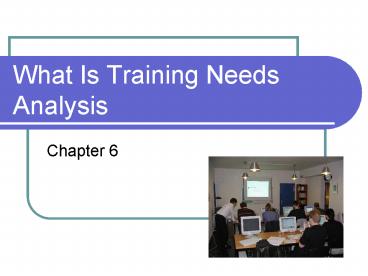What Is Training Needs Analysis - PowerPoint PPT Presentation
1 / 20
Title:
What Is Training Needs Analysis
Description:
Provides a basis for defining organizational needs and training objectives ... without completing a TNA is like selecting a road to take while blindfolded. ... – PowerPoint PPT presentation
Number of Views:8807
Avg rating:3.0/5.0
Title: What Is Training Needs Analysis
1
What Is Training Needs Analysis
- Chapter 6
2
Key Concepts
- Training needs analysis Used to uncover gaps
between adequate and inadequate job performance.
Provides a basis for defining organizational
needs and training objectives derived from the
needs.
3
Key Concepts
- Surveillance Initial TNA stage monitoring
information in order to compile a broad picture
of the organizations performance. - Investigation Middle TNA stage probing areas
that show symptoms of training needs.
4
Key Concepts
- Analysis Final TNA stage sorting and
classifying data from TNA investigation, and then
preparing a report.
5
Objectives of TNA
- What is being done now.
- What should be done now and later.
6
If find Gap--
- Decide if training can be used to close gap.
- Use data collected to determine the following
- Content and method
- Target population for training
- Time constraints for entire training and for
individual tasks - Measurements for training outcomes.
7
How to do a TNA
- Surveillance
- Investigation
- Analysis
8
1. Surveillance
- Regularly review the vital data of your
organization. - Up-to-date status of organization
- Broad picture of organization
- Informal contacts with members of organization
- Keep records of data. See surveillance data
sheet in text p. 75
9
2. Investigation
Gather information when training needs are
identified or requested by management/ employees.
- Observation
- Interviews
- Questionnaires
- Diaries
- Work samples
- Performance appraisals
- Organization and method studies work studies
- Psychological tests
10
3. Analysis
- Examining data, eliminating invalid information,
grouping information, summarizing information,
drawing logical conclusions, preparing reports. - Three major divisions of analysis
- Organizational analysis
- Operations (job) analysis
- Person analysis
11
- Organizational analysis statement of objectives
and policies at organization, department, and
section levels availability of human resources
and organization climate. - Operations (job) analysis standards of job
performance component tasks of jobs ways of
performing tasks. - Person analysis employee in job being analyzed
current level of performance and measurement
standards.
12
Conclusion
We have thus defined the training need, the
training objectives, the training content, and
the target population, which puts us well on the
way to developing training activities appropriate
to the need.
13
Relationships of the TNA Stages
- Surveillance is a continuous activity A-F
- Surveillance and analysis in A recognize need at
B. - Investigation increase in C to D and analysis
increases as well. - Analysis of investigation continues through to E.
- Surveillance continues through to F and begins
again.
14
Support From Management
- Approval to investigate, gather sensitive data.
- Provides resources for investigation and
training. - Encourages improvement and training possibilities
as an attitude.
15
Problems of TNA
- Rewards trainers are not rewarded and,
therefore, reduce reinforcement for initiating
and engaging in training. - Time large amounts of time are invested in TNA
could be used for other activities.
16
Problems of TNA
- Selling TNA because of lengthy time involved,
immediate rewards not always seen management
often has to be sold on TNA.
17
Problems of TNA
- Timeliness trainers often given unrealistic
training deadlines. (new equipment in, everyone
trained by Friday). - Cause and effect make sure training is directed
to cause not to a symptom.
18
Comment
- Developing a program without completing a TNA is
like selecting a road to take while blindfolded.
The philosophyall we can do is hopeunderlying
such an approach is just not good enough for
professional decision makers.
19
Summary
- TNA objective is twofold
- To collect and evaluate information in order to
find out what is being done NOW. - To collect and evaluate information in order to
find out what should be done NOW AND LATER.
20
Summary
- TNA activities are in three stages
- Surveillance
- Investigation
- Analysis































